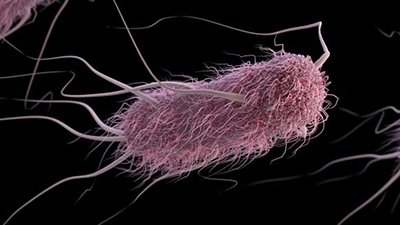
Secret of Self-Propelled Corkscrew Revealed
Secret of self-propelled cyanobacterium’s internal corkscrew unveiled.
News Source
- New Scientist: “Zoologger: Bug evolved a self-propelling corkscrew”
Ubiquitous in the world’s oceans, the tiny Synechococcus, a kind of cyanobacteria, motors mysteriously along without benefit of flagella or cilia or any other visible means of propulsion. How does it do it? Kurt Ehlers and George Oster have figured it out.
They developed their model by comparing electron micrographs of Synechococcus to the unusual internal mechanics of a microorganism that wriggles through slimy dirt. Mathematical simulations confirmed their proposed model could generate the swimming speed Synechococcus achieves in water. Furthermore, by observing the handicap imposed by a mutation, they elucidated the function of an integral part of the locomotor mechanism of this unusual microbe.
Ehlers and Oster discovered that inside Synechococcus is a continuous looped helical molecular track—a sort of a corkscrew. Powered by proton transport, tiny protein motors seem to travel along this helical track causing outer surface distortions. These distortions generate coordinated waves on the surface. By themselves, however, these waves would not be powerful enough to propel Synechococcus forward.
The microbe’s surface is covered with a layer of crystalline molecules called an S-layer. These crystals are placed at precise 60° angles. The crystals in the S-layer amplify the wave motion of the surface distortions, enabling the microbe to motor through the water. The S-layer is an expression of a gene called SwmA. If SwmA is mutated then the microbe can spin in place but not travel forward, confirming that without both the S-layer and the helical motor, Synechococcus could not swim.
The researchers who discovered the secret of Synechococcus’s success make no evolutionary claims in their published work.1 However, the journalist covering the story for NewScientist, after mentioning that the rotating axles of flagella “drive creationists nuts,” wrote, “It seems nature didn’t just evolve the rotating axle: it also evolved a self-propelled corkscrew.”
The flagellum is an irreducibly complex molecular machine. It is made of many essential parts, and it will not function as a means of locomotion unless all are present.
The flagellum is an irreducibly complex molecular machine. It is made of many essential parts, and it will not function as a means of locomotion unless all are present. The flagellum’s parts include a rotating axle, a power source utilizing proton transport, and a whip-like structure made of many proteins.
Evolutionists try to get around the problem of irreducible complexity by claiming each part of the flagellum evolved for other uses. Then, they say, when all the parts finally finished evolving, they were co-opted to make functional flagella for locomotion. However, from an evolutionary point of view there is no reason a part transitioning to its new function would be preserved in its intermediate state until all parts were ready. Many complex components require additional complex molecular machinery for their assembly. And at least 30 of the 40 essential components are unexplainable by co-option. (Read more about flagella at The Amazing Motorized Germ.)
Similarly, these newly described molecular corkscrew wave-generators appear to be another marvelous example of irreducibly complex design. Evolution cannot explain the source of all the information to build flagella or the Synechococcus’s locomotive mechanism. Even the fact that the mutation of just the gene responsible for the wave-amplifying S-layer reduces the Synechococcus to an aimlessly spinning paralytic hints at the irreducibly complex design of our creative Creator God.
Further Reading
For More Information: Get Answers
Remember, if you see a news story that might merit some attention, let us know about it! (Note: if the story originates from the Associated Press, FOX News, MSNBC, the New York Times, or another major national media outlet, we will most likely have already heard about it.) And thanks to all of our readers who have submitted great news tips to us. If you didn’t catch all the latest News to Know, why not take a look to see what you’ve missed?
(Please note that links will take you directly to the source. Answers in Genesis is not responsible for content on the websites to which we refer. For more information, please see our Privacy Policy.)
Recommended Resources

Answers in Genesis is an apologetics ministry, dedicated to helping Christians defend their faith and proclaim the good news of Jesus Christ.
- Customer Service 800.778.3390
- © 2024 Answers in Genesis






